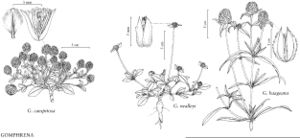Difference between revisions of "Gomphrena nealleyi"
Bot. Gaz. 17: 349. 1892.
Common names: Nealley’s globe-amaranth
FNA>Volume Importer |
FNA>Volume Importer |
||
| Line 47: | Line 47: | ||
|publication year=1892 | |publication year=1892 | ||
|special status= | |special status= | ||
| − | |source xml=https://jpend@bitbucket.org/aafc-mbb/fna-data-curation.git/src/ | + | |source xml=https://jpend@bitbucket.org/aafc-mbb/fna-data-curation.git/src/8f726806613d60c220dc4493de13607dd3150896/coarse_grained_fna_xml/V4/V4_893.xml |
|genus=Gomphrena | |genus=Gomphrena | ||
|species=Gomphrena nealleyi | |species=Gomphrena nealleyi | ||
Revision as of 17:31, 18 September 2019
Plants perennial, not cespitose, 1–4 dm; roots primary, fusiform, fleshy. Stems erect or ascending, pilose. Leaves sessile; blade green, obovate to oblong or spatulate, 1.5–4 × 0.6–1.5 cm, apex rounded, pilose-sericeous abaxially. Inflorescences: heads white or pinkish, subglobose to short-cylindric, 10–12 mm diam.; bractlets crested along keels. Flowers: tube densely lanate; perianth lobes stramineous, lanceolate, 4.5–4.7 mm, indurate, apex spinose-tipped. Utricles ovoid, 2 mm, apex acute. Seeds subglobose to ovoid, 1.5–1.6 mm.
Phenology: Flowering winter–summer.
Habitat: Grasslands, sandy soils
Elevation: 0-10 m
Discussion
Selected References
None.
Lower Taxa
None.

